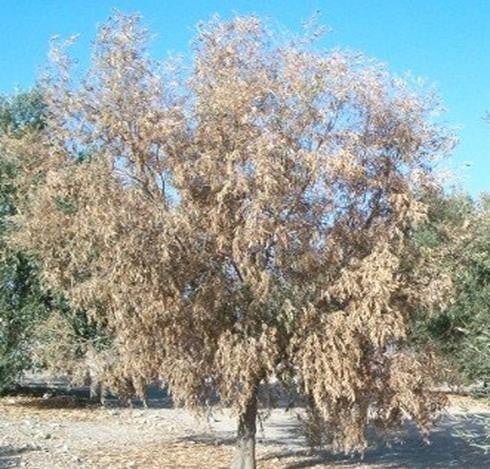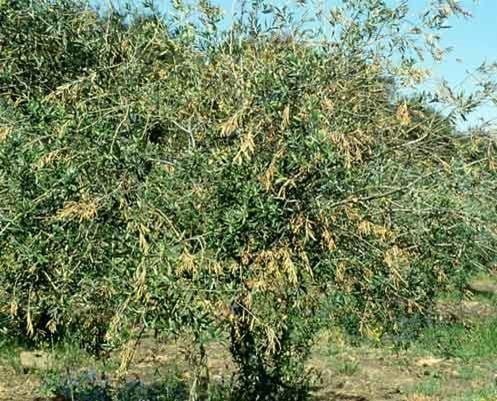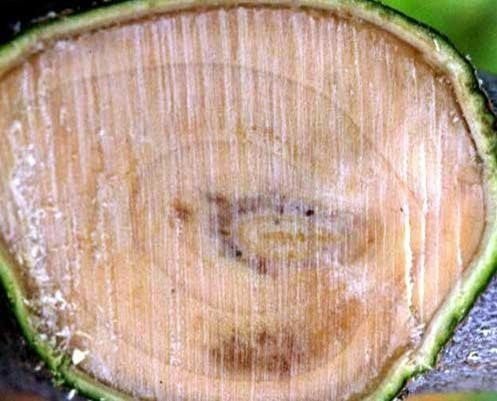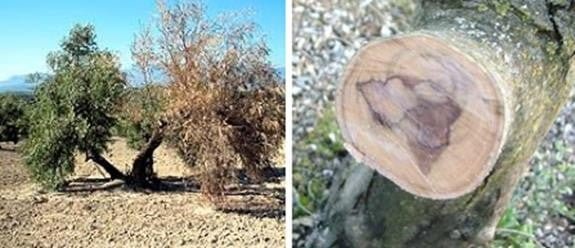Table of contents of the article
ToggleVerticillium wilting of Olives is a fungal disease that affects olive trees, causing a deterioration in their health and productivity. And in this article on your site botanist WORLD of PLANTS, we will review the symptoms of this disease and methods of control for the preservation of olive trees.
- Name of the disease: Wilting of verticillum for olives
- English name: Olive Verticillium Wilt
- Scientific name: Verticillium dahliae
- Type of disease: Fungal disease
- The platoon: Plectosphaerellaceae
Symptoms of verticillium wilting disease of Olives
- Verticillum wilting of Olives is a vascular disease that causes wilting, leaf shedding and branch death in olive trees.
- Initial symptoms may include yellowing or pallor of the leaves, starting from the lower branches and progressing upwards.
- As the disease progresses, the leaves may turn brown and fall off prematurely.
- On the affected branches may appear discoloration of vegetative vessels, in which the wood of the vessels turns vegetative brown or dark brown.
- In severe cases, the entire tree may wither and die.





Causes of verticillium wilting disease of Olives
- This disease is caused by the soil fungus Verticillium dahliae and V. albo-atrum.
- The disease cycle begins with the presence of these fungi in the soil, where they can survive for many years in the form of saptate spores (condensed masses of thick-walled cells) or mycelium spinning in plant residues.
- When the roots of Olives come into contact with the spores of the fungus in the soil, the fungus can penetrate and colonize the vascular system of the plant (wood vessels).
- Once inside the plant, the fungus can spread throughout the plant systematically, causing blockage of vascular tissue, symptoms of wilting and death of branches.
- As the disease progresses, the fungus can produce more Sapot spores or fungal spindle fragments within the tissues of the affected plant.
- These spores can be released into the soil when the plant material decomposes, becoming a source of infection in the future.
The course of verticillium wilting disease of Olives
- The disease cycle can also be continued by the movement of infected plant material, contaminated soil or contaminated tools and supplies.
- The fungus can remain in the soil for many years, even in the absence of family plants, which makes it difficult to break the disease cycle once the pathogen is established in an area.
- The spread of verticillium wilt can be increased by factors such as poor soil drainage, high soil moisture levels, and environmental stress (such as drought or temperature extremes) that weaken the plant's defenses.
Losses caused by verticillium wilting of Olives
- Verticillium wilting of Olives can cause significant economic losses in olive production due to a decrease in yield, deterioration of trees, and in severe cases the death of trees.
- The disease can also affect the quality of olive oil produced from infected trees.
Strategy for combating verticillium wilting disease of Olives
- The fight against verticillium wilting of Olives involves an integrated approach, including the use of resistant or tolerant olive varieties, proper soil drainage and irrigation management, avoidance of contaminated soil transfer, application of soil fumigation coefficients or biocontrol agents.
Preventive measures for verticillium wilting disease of Olives
- Preventive measures include the use of disease-free planting material, the practice of crop alternation with non-host plants, improving soil drainage, avoiding excessive moisture in the soil.
- Maintaining plant vigor through proper fertilizing and watering can also help reduce susceptibility to disease.
Organic/chemical control of verticillium wilt disease of Olives
- For organic control, biocontrol agents such as certain strains of Trichoderma mushrooms or bacteria Bacillus subtilis and Pseudomonas fluorescens can be applied to the soil or incorporated into organic fertilizers.
- These beneficial microorganisms can help suppress the growth of Verticillium dahliae through various mechanisms, including competition, antigenicity and induced systemic resistance.
In conventional agriculture, fumigating the soil with chemical fumigants such as methyl bromide or dynosep can be effective in reducing the levels of infection with Verticillium dahliae fungi in the soil.
- However, these pesticides are highly toxic and have environmental concerns.
- Alternative chemical control methods include the use of systemic fungicides such as fluipiram or benzofendifluber, which can be applied as soil dipping agents or injections of Onyx to protect or treat infected trees.
In conclusion, we would like to note that we, at the world of plants website, offer you all the necessary services in the world of plants, we provide all farmers and those interested in plants with three main services::-
- Artificial intelligence consulting service to help you identify diseases that affect plants and how to deal with them.
- Blog about plants, plant diseases and care of various crops ... You are currently browsing one of her articles right now.
- An application that provides agricultural consultations to clients, as well as a service for imaging diseases and knowing their treatment for free – Click to download the Android version from Google Play Store، Click to download the IOS version from the Apple App Store.




